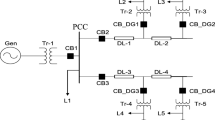Abstract
This paper proposes a reactive power variation method based on positive feedback to improve islanding detection for distributed generation. The proposed strategy has a simple structure. The first part involves injecting a constant reactive power and the second part involves injecting a continuously increasing reactive power with positive feedback. Under the islanding condition, the first part serves to initially activate positive feedback by shifting the point of common coupling frequency into a certain operating point. Then the second part plays an important role in accelerating the frequency shift into the over/under threshold level direction. This method does not have a non-detection zone due to the combination of the two parts, and it has good performance regardless of the load conditions. The performance of the proposed method is verified through experiments in a 1.7 kW system, where the detection time is 53 ms with an over-threshold value of 60.5 Hz and 150 ms with an under-threshold value of 57 Hz.














Similar content being viewed by others
References
Blaabjerg, F., Teodorescu, R., Liserre, M., Hansen, S.: Overview of control and grid synchronization for distributed power generation systems. IEEE Trans. Ind. Electron. 53(5), 1398–1409 (2006)
Hernandez-Gonzalez, G., Iravani, R.: Current injection for active islanding detection of electronically-interfaced distributed resources. IEEE Trans. Power. Del. 21(3), 1698–1705 (2006)
IEEE Standard for interconnection and interoperability of distributed energy resources with associated electric power systems interfaces, IEEE standard 1547–2018 (2018)
Petrone, G., Spagnuolo, G., Teodorescu, R., Veerachary, M., Vitelli, M.: Reliability issues in photovoltaic power processing systems. IEEE Trans. Ind. Electron. 55(7), 2569–2580 (2008)
Raza, S., Arof, H., Mokhlis, H., Mohamad, H., Illias, H.A.: Passive islanding detection techniques for synchronous generators based on performance ranking of different passive parameters. IET Gen. Trans. Dis. 11(17), 4175–4183 (2017)
Ye, Z., Kolwalkar, A., Zhang, Y., Du, P., Walling, R.: Evaluation of anti-islanding schemes based on nondetection zone concept. IEEE Trans. Power Electron. 19(5), 1171–1176 (2004)
Zeineldin, H.H., El-Saadany, E.F., Salama, M.M.A.: Impact of DG interface control on islanding detection and nondetection zones. IEEE Trans. Power Del. 21(3), 1515–1523 (2006)
Wang, X., Freitas, W., Xu, W.: Dynamic Non-detection zones of positive feedback anti-islanding methods for inverter-based distributed generators. IEEE Trans. Power Del. 26(2), 1145–1145 (2011)
Zhu, X., Shen, G., Xu, D.: Evaluation of AFD islanding detection methods based on NDZs described in power mismatch space. IEEE Energy Conversion Congress and Exposition, 2733–2739 (2009)
Salles, D., Freitas, W., Vieira, J.C.M., Venkatesh, B.: A practical method for nondetection zone estimation of passive anti-islanding schemes applied to synchronous distributed generators. IEEE Trans. Power Del. 30(5), 2006–2076 (2015)
W. Bower, M. Ropp: Evaluation of islanding detection methods for utility-interactive inverters in photovoltaic systems. SANDIA Report SAND 2002–3591, Albuquerque, NM: Sandia National Labs (2002)
Lopes, L.A.C., Sun, H.: Performance assessment of active frequency drifting islanding detection methods. IEEE Trans. Energy Conv. 21(1), 171–180 (2006)
Khodaparastan, M., Vahedi, H., Khazaeli, F., Oraee, H.: A novel hybrid islanding detection method for inverter-based DGs using SFS and ROCOF. IEEE Trans. Power Del. 32(5), 2162–2170 (2017)
Zeineldin, H.H.: A Q–f Droop Curve for facilitating islanding detection of inverter-based distributed generation. IEEE Trans. Power Electron. 24(3), 665–673 (2009)
Chen, X., Li, Y.: An islanding detection algorithm for inverter-based distributed generation based on reactive power control. IEEE Trans. Power Electron. 29(9), 4672–4683 (2014)
Chen, X., Li, Y.: An islanding detection method for inverter-based distributed generators based on the reactive power disturbance. IEEE Trans. Power Electron. 31(5), 3559–3574 (2016)
Raipala, O., Makinen, A., Repo, S., Jaraventausta, P.: An anti-islanding protection method based on reactive power injection and ROCOF. IEEE Trans. Power Del. 32(1), 401–410 (2017)
Zhang, J., Xu, D., Shen, G., Zhu, Y., Hee, N., Ma, J.: An improved islanding detection method for a grid-connected inverter with intermittent bilateral reactive power variation. IEEE Trans. Power. Electron. 28(1), 268–278 (2013)
Zhu, Y., Xu, D., He, N., Ma, J., Zhang, J., Zhang, Y., Shen, G., Hu, C.: A novel RPV (reactive-power-variation) anti-islanding method based on adapted reactive power perturbation. IEEE Trans. Power Electron. 28(11), 4998–5012 (2013)
Kim, S., Jeon, J., Ahn, J., Lee, B., Kwon, S.: Frequency-shift acceleration control for anti-islanding of a distributed-generation inverter. IEEE Trans. Ind. Electron. 57(2), 494–504 (2010)
Jo, J., Cha, H.: Performance of anti-islanding of an improved reactive power variation method based on positive feedback. Proc. IEEE Energy Conversion Congress and Exposition, 4761–4765 (2017)
Acknowledgements
This work is supported by the 2018 Open R&D Program of Korea Electric Power Corporation (KEPCO) (No.R18DO02).
Author information
Authors and Affiliations
Corresponding author
Rights and permissions
About this article
Cite this article
Jo, J., Cha, H. A novel anti-islanding method using positive feedback reactive power variation. J. Power Electron. 20, 991–1001 (2020). https://doi.org/10.1007/s43236-020-00082-y
Received:
Revised:
Accepted:
Published:
Issue Date:
DOI: https://doi.org/10.1007/s43236-020-00082-y




